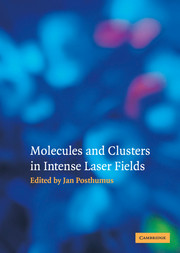Book contents
- Frontmatter
- Contents
- Preface
- 1 Ultra-high-intensity lasers based on Ti: sapphire
- 2 Diatomic molecules in intense laser fields
- 3 Small polyatomic molecules in intense laser fields
- 4 Coherent control in intense laser fields
- 5 Experimental studies of laser-heated rare-gas clusters
- 6 Single-cluster explosions and high-harmonic generation in clusters
- 7 Interactions of intense laser beams with extended cluster media
- Index
5 - Experimental studies of laser-heated rare-gas clusters
Published online by Cambridge University Press: 29 March 2010
- Frontmatter
- Contents
- Preface
- 1 Ultra-high-intensity lasers based on Ti: sapphire
- 2 Diatomic molecules in intense laser fields
- 3 Small polyatomic molecules in intense laser fields
- 4 Coherent control in intense laser fields
- 5 Experimental studies of laser-heated rare-gas clusters
- 6 Single-cluster explosions and high-harmonic generation in clusters
- 7 Interactions of intense laser beams with extended cluster media
- Index
Summary
Introduction
The advent of compact, high-power lasers in the last two decades has opened a rich and challenging research field, aimed at understanding the behaviour of matter under the influence of ultra-intense and extremely short pulses of light. Typical pulse durations of less than 10−13 s are now available with commercial laser systems that are designed to deliver peak powers beyond 1012 W. The focusing of such laser pulses leads to extremely high energy intensities that may exceed 1018 W cm−2. The corresponding electric-field strengths are of the order of several GV cm−1 and megagauss magnetic fields. In terms of photon numbers, at 1017 W cm−2 the irradiation is already so intense that approximately 10000 photons will pass through the volume of one atom during each optical cycle (3 fs).
In the last few decades, extensive strong-laser-field studies have been performed on atomic targets in the gas phase as well as on bulk solidstate targets. Several pertinent phenomena in strong fields were discovered as a result of the non-linear response of matter to intense laser irradiation. For the particular case of atoms in the gas phase, multi-photon ionisation (MPI) and optical field ionisation (OFI) have been studied in great detail both experimentally and theoretically. Moreover, the observation of highly non-linear phenomena such as above-threshold ionisation (ATI) and high-order-harmonic generation (HHG) and their detailed theoretical description have lead to a comprehensive understanding of the principal physical processes that govern the atomic response to intense laser fields.
- Type
- Chapter
- Information
- Molecules and Clusters in Intense Laser Fields , pp. 142 - 176Publisher: Cambridge University PressPrint publication year: 2001
- 1
- Cited by



